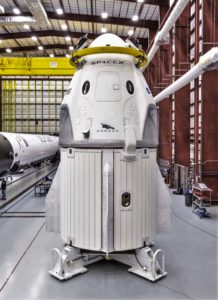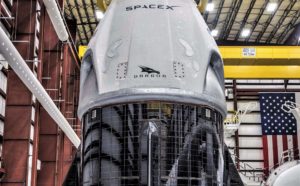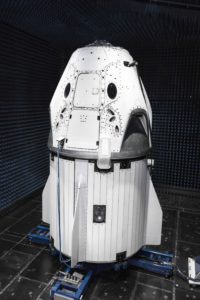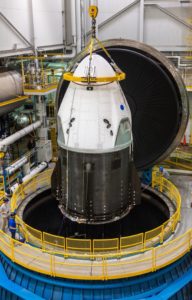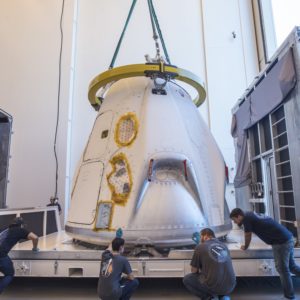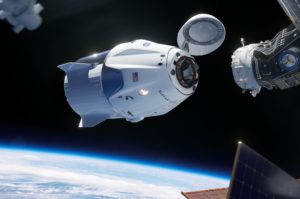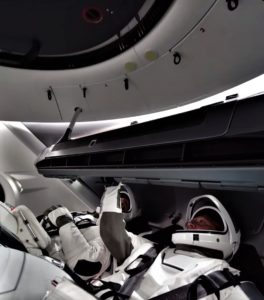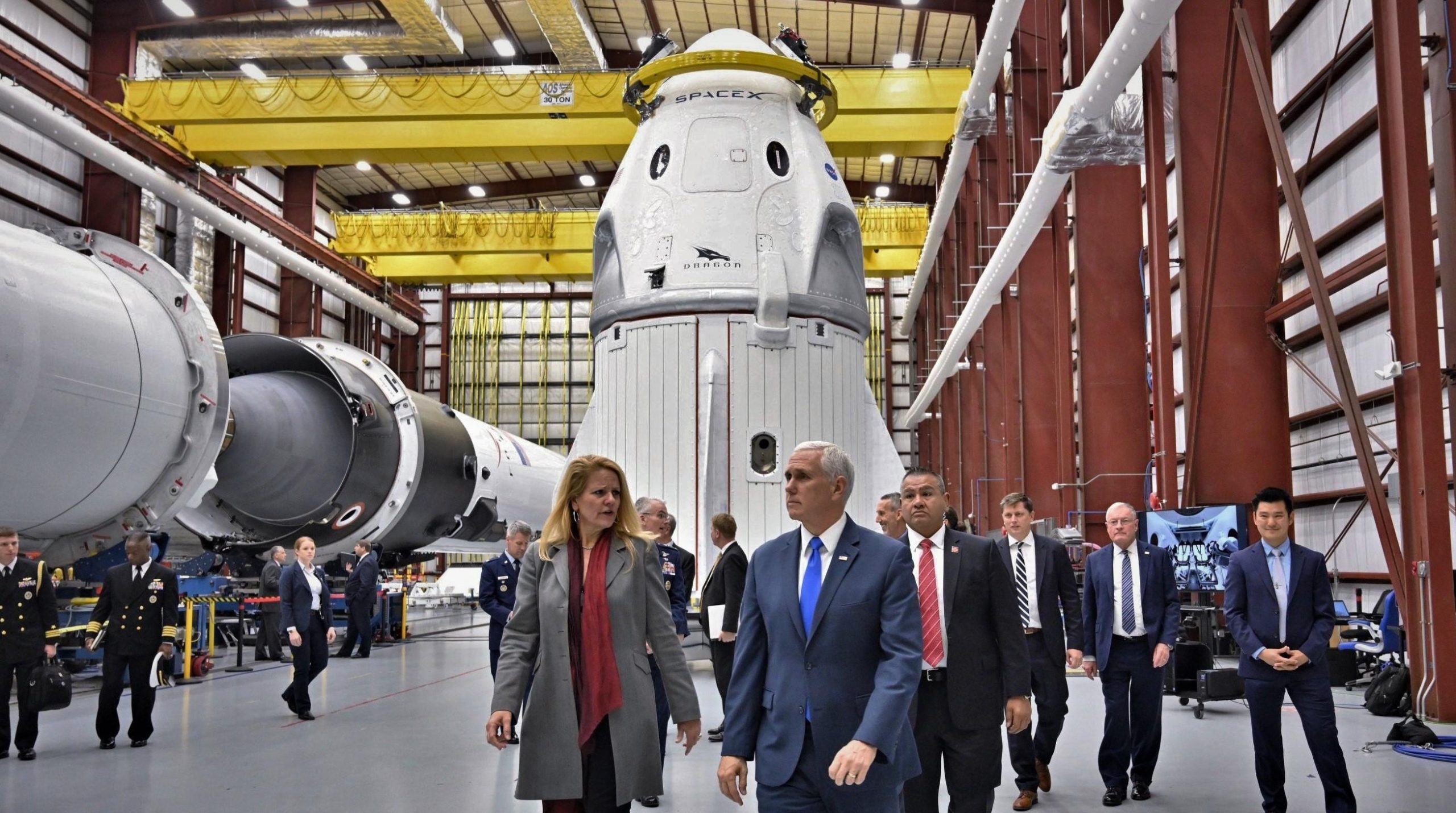
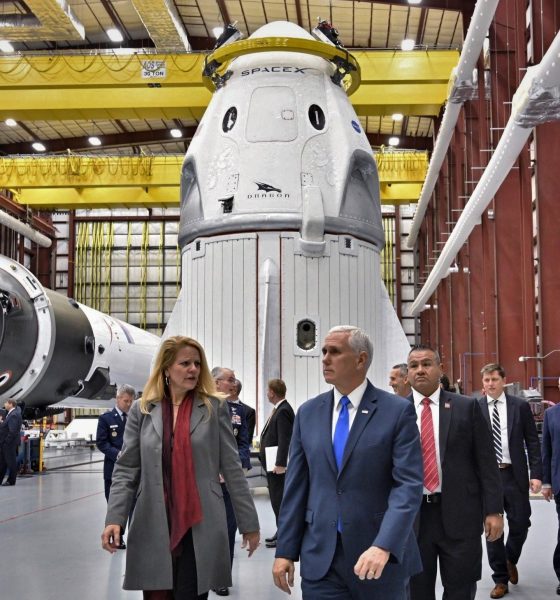
SpaceX
SpaceX shows off first completed Crew Dragon spaceship with new Falcon 9
New photos posted from an official tour of SpaceX’s Pad 39A launch facilities reveal that SpaceX has effectively completed integration and preflight preparations of the company’s first flightworthy Crew Dragon spacecraft, as well as the new Falcon 9 Block 5 rocket that will be tasked with launching it early next year.
Currently targeting launch no earlier than (NET) January 17th, this inaugural Crew Dragon launch – known as Demonstration Mission 1 (DM-1) – will be conducted without a crew aboard to ensure that the spacecraft’s performance and characteristics fit within design parameters, hopefully giving NASA the data it needs to certify Crew Dragon to launch astronauts as early as June 2019.
omfg @spacex just posted some absolutely stunning photos inside Pad 39A's hangar: meet the first completed Crew Dragon and its Falcon 9 Block 5 rocket (B1051) 😀 In the far left (second photo), you can also see what is probably B1047 in the midst of refurbishment. pic.twitter.com/NWULyAEhpQ
— Eric Ralph (@13ericralph31) December 18, 2018
Aside from the wonderful fact that all (or nearly all) of the hardware needed for Crew Dragon’s launch debut can be seen in the four photos posted today, this is also the first time SpaceX has ever provided a real photo of the next-gen spacecraft’s trunk-based solar array. A dramatic departure from Cargo Dragon’s more traditional duo of multi-panel solar arrays, which deploy from disposable covers and fold out like wings, SpaceX decided from the start that Crew Dragon would take a much different approach. In a move that presumably cut the risk of solar array deployment, Crew Dragon’s panels are conformally attached (i.e. curved to fit) to the disposable trunk’s rear exterior.
Incredible opportunity to see @SpaceX's Dragon 2 Capsule – an important part of the future of American human space exploration as we aim to return American astronauts to space on U.S. rockets from U.S. soil! pic.twitter.com/Pk5lkpOFEX
— Vice President Mike Pence Archived (@VP45) December 18, 2018
Rather than deploying its arrays like wings, Crew Dragon will always have its solar cells ready and waiting to generate power, simply requiring the spacecraft to face one half of its trunk towards the sun. According to a few individuals involved with the trunk, guaranteeing food fitment between individual cells and subsections and avoiding the problems caused by different thermal expansion coefficients (shrinking and expanding as the temperature changes) was no easy task and led to many, many headaches in the final weeks of integration and testing. From a less objective standpoint, Crew Dragon’s new conformal solar array is absolutely stunning, and it will be a shame to see each sculpture-like trunk relegated to a destructive atmospheric reentry after each launch.
Pragmatically speaking, it’s extremely satisfying to see all the hardware (both rocket and spacecraft) effectively under the same roof at the launch pad they will soon lift off from. Much like Falcon Heavy, NASA’s Commercial Crew Program (CCP) has been beset with the better part of two years of delays from original launch targets in 2017 for both Boeing and SpaceX. Since then, a combination of NASA bureaucracy and technical/programmatic stumbles made by both companies have conspired to almost indefinitely delay the first uncrewed and crewed trips to orbit.
- At long last, SpaceX’s first completed Crew Dragon has been integrated with a flightworthy trunk and is awaiting attachment to Falcon 9. (SpaceX)
- The first complete Crew Dragon is likely just days away from rolling out to Pad 39A atop Falcon 9. (SpaceX)
- The DM-1 Crew Dragon testing inside SpaceX’s anechoic chamber, May 2018. (SpaceX)
- SpaceX’s Demo Mission-1 Crew Dragon seen preparing for vacuum tests at a NASA-run facility, June 2018. (SpaceX)
- The first spaceworthy Crew Dragon capsule is already in Florida, preparing for its November 2018 launch debut. The same capsule will be refurbished and reflown as few as three months after recovery. (SpaceX)
- Crew Dragon arrives at ISS. (SpaceX)
- DM-2 astronauts Bob Behnken and Doug Hurley train for their first flight in Crew Dragon. (NASA)
SpaceX suffered catastrophic Falcon 9 failures in both 2015 and 2016 and has largely been working to ameliorate the technical and organizational flaws that allowed those anomalies to occur, while also having to convince NASA that they are ready to safeguard the lives of the space agency’s astronauts. Since SpaceX’s last known total vehicle failure in September 2016, Falcon 9 and Falcon Heavy have managed an extraordinary 37 successful launches in a row in a little more than 24 months.
SpaceX is targeting Crew Dragon’s first orbital launch sometime in January 2019, with the placeholded launch date currently sitting on January 17th, pending International Space Station (ISS) availability and NASA’s go-ahead. Given the presence of Falcon 9 B1051 in 39A’s integration hangar and the fact that SpaceX technicians already appear to be integrating the first and second stages, the company may well be ready to perform a full-up dress rehearsal – involving Falcon 9 and Crew Dragon rolling out and going vertical on Pad 39A – before 2018 is out.
For prompt updates, on-the-ground perspectives, and unique glimpses of SpaceX’s rocket recovery fleet check out our brand new LaunchPad and LandingZone newsletters!

Elon Musk
Elon Musk gives nod to SpaceX’s massive, previously impossible feat
It was the booster’s 30th flight, a scenario that seemed impossible before SpaceX became a dominant force in spaceflight.
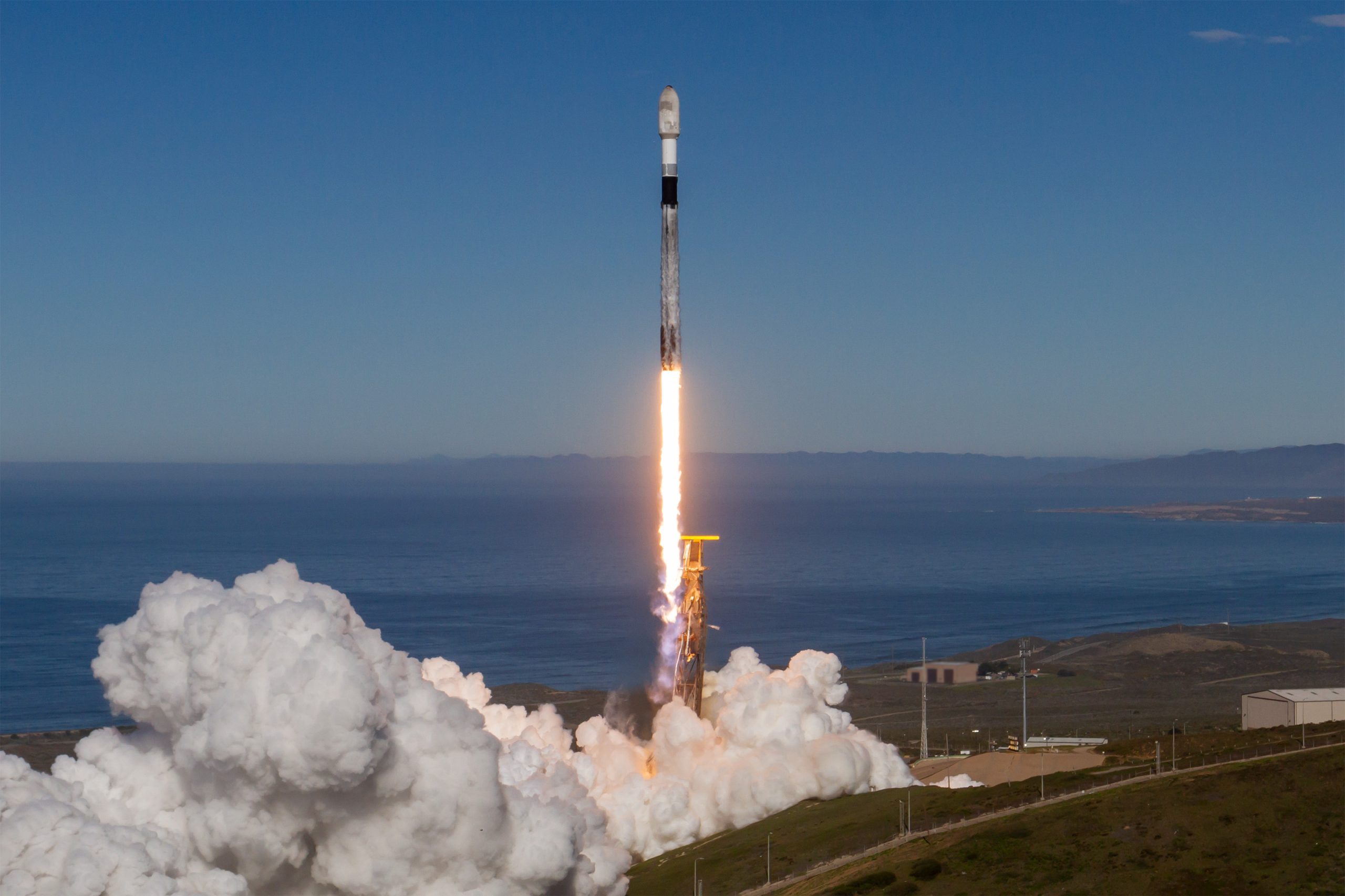
Elon Musk gave a nod to one of SpaceX’s most underrated feats today. Following the successful launch of the Transporter-15 mission, SpaceX seamlessly landed another Falcon 9 booster on a droneship in the middle of the ocean.
It was the booster’s 30th flight, a scenario that seemed impossible before SpaceX became a dominant force in spaceflight.
Elon Musk celebrates a veteran Falcon 9 booster’s feat
SpaceX completed another major milestone for its Smallsat Rideshare program on Friday, successfully launching and deploying 140 spacecraft aboard a Falcon 9 from Vandenberg Space Force Base. The mission, known as Transporter-15, lifted off two days later than planned after a scrub attributed to a ground systems issue, according to SpaceFlight Now. SpaceX confirmed that all payloads designed to separate from the rocket were deployed as planned.
The Falcon 9 used for this flight was booster B1071, one of SpaceX’s most heavily flown rockets. With its 30th mission completed, it becomes the second booster in SpaceX’s fleet to reach that milestone. B1071’s manifest includes five National Reconnaissance Office missions, NASA’s SWOT satellite, and several previous rideshare deployments, among others. Elon Musk celebrated the milestone on X, writing “30 flights of the same rocket!” in his post.
Skeptics once dismissed reusability as unfeasible
While rocket landings are routine for SpaceX today, that was not always the case. Industry veterans previously questioned whether reusable rockets could ever achieve meaningful cost savings or operational reliability, often citing the Space Shuttle’s partial reusability as evidence of failure.
In 2016, Orbital ATK’s Ben Goldberg argued during a panel that even if rockets could be reusable, they do not make a lot of sense. He took issue with Elon Musk’s claims at the time, Ars Technica reported, particularly when the SpaceX founder stated that fuel costs account for just a fraction of launch costs.
Goldberg noted that at most, studies showed only a 30% cost reduction for low-Earth orbit missions by using a reusable rocket. “You’re not going to get 100-fold. These numbers aren’t going to change by an order of magnitude. They’re just not. That’s the state of where we are today,” he said.
Former NASA official Dan Dumbacher, who oversaw the Space Launch System, expressed similar doubts in 2014, implying that if NASA couldn’t make full reusability viable, private firms like SpaceX faced steep odds.
Elon Musk
SpaceX’s Starship program is already bouncing back from Booster 18 fiasco
Just over a week since Booster 18 met its untimely end, SpaceX is now busy stacking Booster 19, and at a very rapid pace, too.
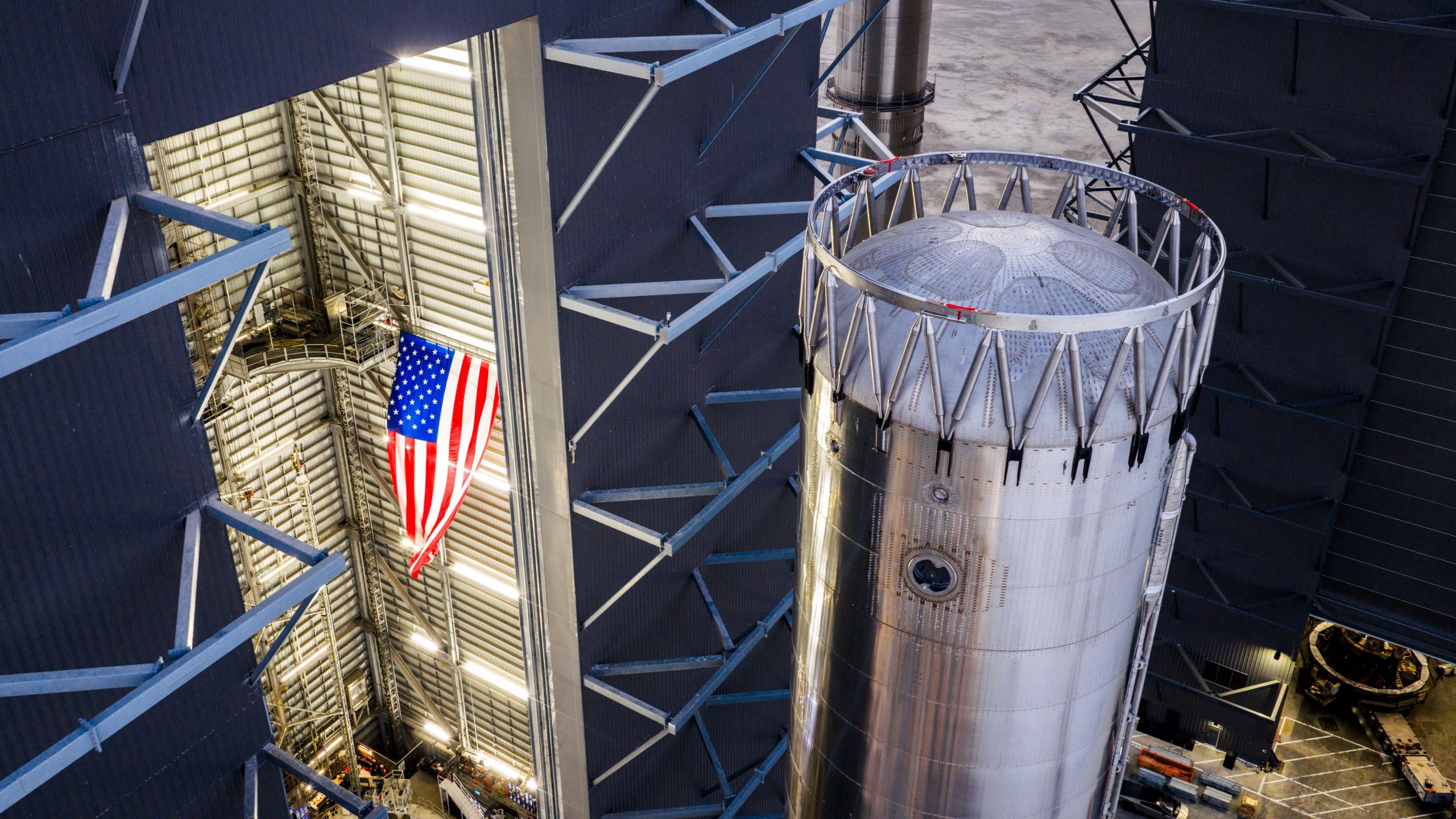
SpaceX is already bouncing back from the fiasco that it experienced during Starship Booster 18’s initial tests earlier this month.
Just over a week since Booster 18 met its untimely end, SpaceX is now busy stacking Booster 19, and at a very rapid pace, too.
Starship V3 Booster 19 is rising
As per Starbase watchers on X, SpaceX rolled out the fourth aft section of Booster 19 to Starbase’s MegaBay this weekend, stacking it to reach 15 rings tall with just a few sections remaining. This marks the fastest booster assembly to date at four sections in five days. This is quite impressive, and it bodes well for SpaceX’s Starship V3 program, which is expected to be a notable step up from the V2 program, which was retired after a flawless Flight 11.
Starship watcher TankWatchers noted the tempo on X, stating, “During the night the A4 section of Booster 19 rolled out to the MegaBay. With 4 sections in just 5 days, this is shaping up to be the fastest booster stack ever.” Fellow Starbase watcher TestFlight echoed the same sentiments. “Booster 19 is now 15 rings tall, with 3 aft sections remaining!” the space enthusiast wrote.
Aggressive targets despite Booster 18 fiasco
SpaceX’s V3 program encountered a speed bump earlier this month when Booster 18, just one day after rolling out into the factory, experienced a major anomaly during gas system pressure testing at SpaceX’s Massey facility in Starbase, Texas. While no propellant was loaded, no engines were installed, and no one was injured in the incident, the unexpected end of Booster 18 sparked speculation that the Starship V3 program could face delays.
Despite the Booster 18 fiasco, however, SpaceX announced that “Starship’s twelfth flight test remains targeted for the first quarter of 2026.” Elon Musk shared a similar timeline on X earlier this year, with the CEO stating that “ V3 is a massive upgrade from the current V2 and should be through production and testing by end of year, with heavy flight activity next year.”
Considering that Booster 19 seems to be moving through its production phases quickly, perhaps SpaceX’s Q1 2026 target for Flight 12 might indeed be more than feasible.
Elon Musk
Elon Musk shares SpaceX’s directive that destroys a prevalent media narrative
Musk’s comments followed Starlink’s initiatives for people affected by severe flooding in Indonesia and Cyclone Ditwah in Sri Lanka.

Elon Musk recently shared SpaceX’s standing policy to offer free Starlink service during natural disasters worldwide, highlighting the company’s commitment to pursue aid over profit during times of need.
Musk’s comments followed Starlink’s initiatives for people affected by severe flooding in Indonesia and Cyclone Ditwah in Sri Lanka.
Starlink activates free service in Indonesia and Sri Lanka
Starlink recently announced free service for those impacted by severe flooding in Indonesia’s Sumatra region, partnering with the government to deploy terminals rapidly to the hardest-hit areas. The offer extends to new and existing customers through December, restoring connectivity in zones where traditional networks have failed due to infrastructure damage.
Musk quoted the post on X, writing, “SpaceX standard policy is to make Starlink free whenever there is a natural disaster somewhere in the world. It would not be right to profit from misfortune.”
Starlink extended the same relief to Sri Lanka amid Cyclone Ditwah, coordinating with local authorities for additional support. The cyclone battered the island nation with heavy rains and winds, disrupting communications for thousands. Free access also lasts until year-end, emphasizing Starlink’s role in bridging gaps during crises.
“For those affected by the severe flooding in Indonesia and Sri Lanka in the aftermath of Cyclone Ditwah, Starlink is providing free service to new and existing customers through the end of December 2025. We’re also working with the Indonesian government to rapidly deploy terminals and restore connectivity to the hardest-hit areas on Sumatra, as well as with the Sri Lankan government to provide additional assistance,” Starlink wrote in a post on its official website.
Musk’s companies routinely provide aid
Musk’s firms have a track record of providing critical support in crises, often without fanfare, challenging portrayals of him as a comic book villain intent on enriching himself on the backs of a suffering populace. In January 2024 alone, Tesla opened Superchargers for free in Japan’s Hokuriku region after a magnitude 7.6 earthquake killed at least 55 and injured hundreds.
Similar efforts include Starlink deployments for the 2023 Maui wildfires, 2024 Hurricane Helene in North Carolina, and floods in Texas, where the service was used to help facilitate emergency coordination. These actions, which total millions in waived fees and logistics, demonstrate a proactive ethos among Musk’s companies, with Musk noting in past interviews that such aid stems from engineering solutions over optics.
The initiatives also provide a direct rebuttal of Musk’s characterization on mainstream media, which tends to lean negatively. This has become much more notable in recent years as Musk adopted more conservative policies. These negative sentiments came to a head earlier this year when Tesla stores, vehicles, and even some owners, were attacked during waves of anti-Tesla protests.
